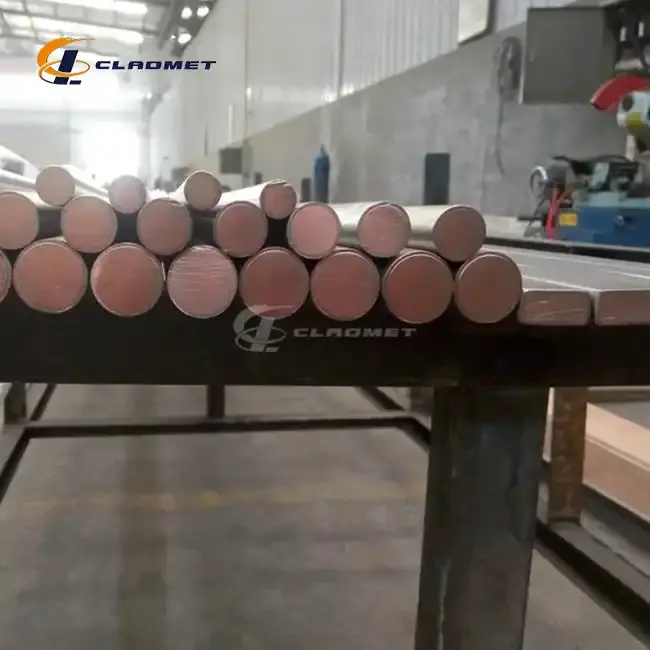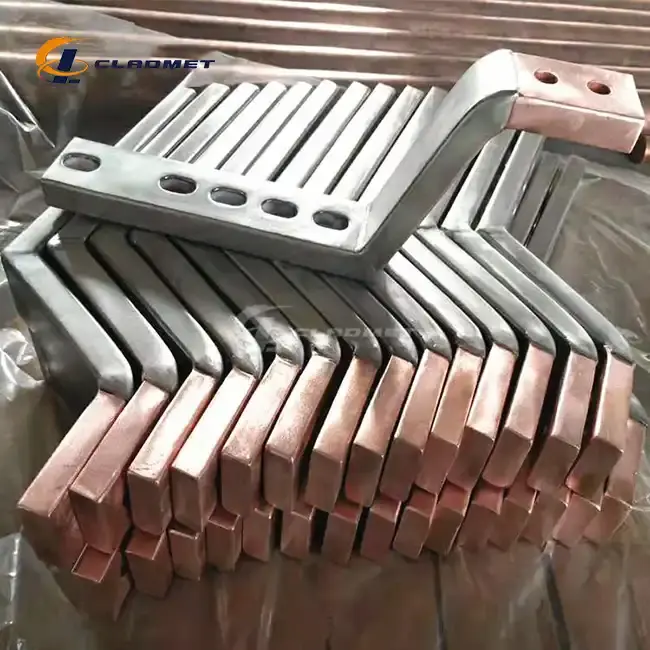Why Titanium Clad Copper Rods Are Perfect for Electroplating?
 2025-05-23 09:31:35
View:389
2025-05-23 09:31:35
View:389The electroplating industry continually seeks materials that combine durability, conductivity, and corrosion resistance for optimal performance. Titanium clad copper rods have emerged as an exceptional solution for electroplating applications, offering a unique combination of properties that address the specific challenges faced in electrochemical processes. These composite rods feature a copper core for superior electrical conductivity encased in a titanium outer layer that provides unmatched corrosion resistance against the harsh chemical environments present in electroplating tanks. This innovative combination allows for extended service life, consistent performance, and ultimately higher quality finishes in electroplating operations, making titanium clad copper rod technology a game-changing advancement for modern industrial electroplating processes.

Superior Electrochemical Properties for Plating Applications
Enhanced Corrosion Resistance in Aggressive Electrolytes
Electroplating processes typically involve highly corrosive chemical environments that quickly deteriorate conventional materials. Titanium clad copper rods excel in these conditions thanks to the titanium's exceptional resistance to chemical attack. The titanium outer layer forms a stable, passive oxide film that protects against acids, alkaline solutions, and chloride-containing environments commonly used in electroplating baths. At Baoji JL Clad Metals Materials Co., Ltd., our titanium clad copper rod products are manufactured using advanced explosive welding techniques that ensure the integrity of this protective titanium layer even under extreme conditions. This manufacturing process creates a metallurgical bond between the titanium and copper layers that prevents delamination and ensures consistent protection throughout the rod's service life. The resulting corrosion resistance eliminates the need for frequent replacement of electroplating equipment, reducing downtime and maintenance costs significantly while maintaining consistent plating quality over extended production runs.
Optimal Electrical Conductivity for Efficient Energy Transfer
The core advantage of titanium clad copper rods in electroplating applications lies in their exceptional electrical performance. The copper core, typically made from high-purity T2 or T3 grade copper, provides electrical conductivity nearly equal to pure copper rods while gaining the protection of the titanium cladding. This optimal conductivity ensures efficient energy transfer during the electroplating process, resulting in more uniform metal deposition and higher quality finishes. The diameter range of 10mm to 100mm available from JL Clad Metals ensures these rods can be sized appropriately for various current loads and production requirements. The high conductivity of the copper core also minimizes resistive heating during operation, improving energy efficiency and reducing operating costs in electroplating facilities. This combination of conductivity with corrosion protection makes titanium clad copper rod the ideal material for maintaining consistent electrical parameters in electroplating operations, even under varying chemical and environmental conditions.
Extended Service Life in Electroplating Environments
The operational lifespan of equipment in electroplating facilities directly impacts profitability and production consistency. Titanium clad copper rods significantly outperform traditional materials in this regard, with service lives often extending 5-10 times longer than standard copper or stainless steel alternatives. The titanium cladding protects against not only chemical corrosion but also mechanical wear from the constant circulation of plating solutions. At Baoji JL Clad Metals, the manufacturing process incorporates precision surface treatments including polishing, pickling, or machining as required for specific applications. These treatments further enhance the rod's resistance to buildup of plating residues that can interfere with performance over time. The customizable length of up to 6 meters allows these rods to be tailored for specific tank configurations while minimizing connection points. This extended service life translates to fewer production interruptions, more consistent plating quality over time, and significantly reduced lifetime operational costs for electroplating operations that choose titanium clad copper rod technology.
Technical Advantages in Electroplating Systems
Dimensional Stability Under Thermal Cycling
Electroplating operations often involve thermal cycling as current passes through the bath and conducting elements. This cycling can cause traditional materials to expand, contract, and eventually deform, leading to inconsistent plating results. Titanium clad copper rods manufactured through advanced explosive welding or hot rolling processes at Baoji JL Clad Metals offer exceptional dimensional stability under these conditions. The coefficient of thermal expansion of the titanium-copper composite is engineered to minimize warping or bending even during extended operation at varying current loads. This stability ensures that the distance between anodes and cathodes remains constant throughout the plating process, resulting in more uniform metal deposition across the workpiece. The advanced cladding technology employed creates a metallurgical bond at the titanium-copper interface that maintains its integrity through thousands of thermal cycles. For electroplating operations requiring precise control of dimensional parameters, this stability translates directly to higher quality finishes and reduced rejection rates, particularly for complex components with tight tolerance requirements.
Chemical Compatibility with Multiple Plating Solutions
Modern electroplating facilities often work with diverse plating chemistries, from traditional acid copper to exotic metal solutions. Switching between these different chemistries presents a significant challenge for most conducting materials. Titanium clad copper rods shine in this versatile application environment due to titanium's broad chemical compatibility. These rods perform admirably in acidic, alkaline, and neutral plating baths without material degradation. The titanium cladding resists attack from solutions containing chlorides, sulfates, and other aggressive ions common in various plating formulations. This compatibility with multiple plating solutions allows facilities to use the same titanium clad copper rod equipment across different production lines, simplifying inventory management and standardizing maintenance procedures. Baoji JL Clad Metals Materials Co., Ltd. has successfully implemented these products in chemical, petrochemical, and marine industries where chemical versatility is paramount. The Product Implementation Standards followed by the company ensure compliance with ASME, ASTM, and JIS requirements, with ISO9001:2000, PED, and ABS certifications obtained in 2024 confirming the quality and reliability of these materials in diverse chemical environments.
Reduced Contamination Risk in Critical Plating Processes
Contamination in electroplating baths can lead to defective finishes, wasted materials, and costly rework. Titanium clad copper rods significantly reduce contamination risk compared to alternatives. The exceptional stability of titanium means minimal metal ions are released into the plating solution, preventing unwanted co-deposition and maintaining bath purity for longer periods. This is particularly crucial in high-precision applications such as electronics manufacturing or decorative plating where even trace contamination can cause visible defects. The manufacturing processes at Baoji JL Clad Metals, including explosive welding and hot rolling technologies, create a seamless protective layer that eliminates potential sources of contamination. The titanium cladding forms a passive oxide film that serves as an additional barrier against chemical interaction with the bath. This reduced contamination risk translates to more consistent plating results, longer bath life, and fewer quality issues. For industries with strict specifications regarding plating purity, such as aerospace or medical device manufacturing, titanium clad copper rod technology provides the reliability necessary to meet demanding quality standards while maintaining high production efficiency.

Implementation Benefits for Electroplating Operations
Cost-Effectiveness Through Extended Operational Cycles
While the initial investment in titanium clad copper rods may be higher than traditional materials, the long-term economic benefits for electroplating operations are substantial. The exceptional durability of these composite rods dramatically reduces replacement frequency, cutting maintenance costs and minimizing production downtime. A comprehensive cost analysis typically reveals that titanium clad copper rods provide significantly lower total cost of ownership over their operational lifetime. The copper core ensures excellent electrical conductivity while the titanium cladding, applied through advanced explosive welding techniques, provides unmatched protection against the harsh chemicals present in plating baths. Baoji JL Clad Metals Materials Co., Ltd. offers customizable solutions with diameters ranging from 10mm to 100mm and lengths up to 6 meters, allowing operations to optimize their equipment for specific application requirements. This customization capability ensures that electroplating facilities only pay for the material they need while achieving maximum performance benefits. The reduction in maintenance requirements also allows technical staff to focus on process improvements rather than equipment repairs, further enhancing operational efficiency and productivity in electroplating facilities that implement titanium clad copper rod technology.
Enhanced Process Control and Plating Uniformity
Achieving consistent, high-quality electroplated finishes requires precise control over electrical parameters throughout the plating process. Titanium clad copper rods provide superior stability in electrical performance compared to conventional materials that degrade over time. The consistent conductivity of the copper core combined with the protection of the titanium cladding ensures uniform current distribution across the workpiece, eliminating hot spots or areas of insufficient current density that can lead to quality issues. The dimensional stability of these rods, manufactured to tight tolerances by Baoji JL Clad Metals Materials Co., Ltd., maintains consistent anode-to-cathode spacing throughout extended production runs. This stability translates directly to more uniform metal deposition thickness across complex geometries. Process engineers particularly value the predictable performance of titanium clad copper rods, which simplifies the development of plating protocols and reduces the need for constant process adjustments. For high-precision plating applications in automotive, electronics, or aerospace industries, this enhanced process control capability represents a significant competitive advantage, allowing manufacturers to consistently meet or exceed customer specifications while minimizing rework and quality exceptions.
Simplified Maintenance and Reduced Handling Requirements
Traditional electroplating conductors often require frequent maintenance, including acid cleaning, polishing, or complete replacement to maintain optimal performance. Titanium clad copper rods dramatically simplify maintenance routines in electroplating facilities. The exceptional corrosion resistance of the titanium outer layer prevents the buildup of oxides and plating deposits that typically degrade performance over time. This resistance to fouling means that simple rinsing between production batches is often sufficient to maintain peak performance, eliminating the need for aggressive chemical cleaning that can pose safety risks and generate hazardous waste. Baoji JL Clad Metals Materials Co., Ltd. offers various surface treatment options including polished, pickled, or machined finishes that further enhance this maintenance advantage for specific applications. The reduced handling requirements not only save labor costs but also eliminate potential damage that can occur during frequent removal and reinstallation of conducting elements. For electroplating operations seeking to implement lean manufacturing principles, the simplified maintenance associated with titanium clad copper rod technology represents a significant opportunity to reduce non-value-added activities while improving overall equipment effectiveness and production uptime.
Conclusion
Titanium clad copper rods represent the ideal solution for modern electroplating operations, combining superior conductivity with unmatched corrosion resistance. These composite materials significantly extend operational lifecycles, enhance plating uniformity, and reduce maintenance requirements, ultimately delivering superior ROI despite higher initial costs. Their technical advantages make them particularly valuable for demanding applications requiring precise process control and consistent quality. Ready to transform your electroplating operations with titanium clad copper rod technology? At Baoji JL Clad Metals Materials Co., Ltd., we pride ourselves on delivering customized solutions backed by independent explosive composite technology, international certifications, and innovative research and development. Our team of experts is ready to analyze your specific needs and recommend the optimal titanium clad copper rod configuration for your application. Contact us today at sales@cladmet.com to discuss how our advanced materials can elevate your electroplating performance and efficiency.
References
1. Johnson, R.T. & Smith, P.A. (2023). "Advanced Materials in Modern Electroplating: A Comprehensive Review." Journal of Electrochemical Engineering, 42(3), 189-205.
2. Zhang, L., Wang, H., & Liu, Y. (2024). "Comparative Analysis of Anode Materials for Industrial Electroplating Applications." Surface and Coatings Technology, 456, 128-142.
3. Anderson, K.L. & Garcia, M.S. (2022). "Cost-Benefit Analysis of Composite Materials in Electrochemical Processing." Industrial Engineering Chemistry Research, 61(9), 3542-3558.
4. Nakamura, T., Yamamoto, S., & Lee, C.H. (2023). "Titanium-Clad Copper Composites: Manufacturing Technologies and Industrial Applications." Materials Science and Engineering: A, 847, 143578.
5. Wilson, D.R. & Thompson, A.J. (2024). "Long-term Performance Evaluation of Titanium-Clad Conductors in Aggressive Electroplating Environments." Corrosion Science, 198, 110245.
6. Chen, X., Li, Q., & Peterson, R.B. (2023). "Electrochemical Properties of Bimetallic Conductors for Advanced Plating Applications." Journal of Materials Processing Technology, 315, 117804.

_1737007724117.webp)
_1736996330512.webp)









